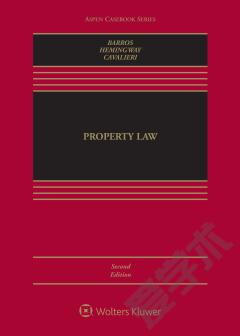Property Law
An innovative Property casebook that re-imagines the law school casebook format and covers all the major topics included in a basic 1L Property course, Property Law, Second Edition borrows some pedagogical features commonly found in undergraduate textbooks, making use of sidebars, illustrations, and other design devices to present material more clearly. The authors present concepts simply, then move the discussion toward complexity—the opposite of the approach taken by many current texts. Clear yet sophisticated, the casebook is the perfect choice for all skill levels. Including problems that students can and should be able to do on their own, explanatory answers, and skills-based exercises, this casebook is both professor-friendly and student-friendly. Themes that run through the course are highlighted throughout the book, resulting in a casebook that clearly presents the fundamentals of property law. This allows students to develop an understanding of basic concepts on their own while allowing professors to assist their students in developing an advanced understanding of property law. The authors of Property Law are experts on the property coverage on the bar exam, and while this casebook goes far beyond test-only material, students will benefit from their expertise and will learn every topic they are likely to see on the bar exam. New to the Second Edition: Additional text on racial discrimination and other critical issues in a subtle way, giving instructors the choice of how deeply to explore those issues. Revisions to Chapter 9 to include Murr v. Wisconsin, the Supreme Court’s most recent regulatory takings case. A Revised Chapter 10 that includes new material on Intellectual Property and Property Theory. Minor corrections and refinements throughout the casebook. Professors and students will benefit from: A text that starts from simplicity and moves to complexity: The book first provides text that explains the basic doctrine, then presents a simple case example, and finally moves to more complex issues. Cases that are introduced with explanatory text discussing the law and issues surrounding the case. This radically different approach from most other casebooks allows students to have a better grasp of the concepts and themes before they even read the case. Problems and exercises that students can complete on their own, with explanatory answers included in an appendix. An innovative design that aids student learning, with sidebars, diagrams, charts, and illustrations that make concepts clearer to students. Cases that are used as examples, not introductions to legal rules. Many topics in the book feature introductory text, illustrations, and problem sets before a single case is introduced, to aid in students’ legal learning. The inclusion of sample documents, helping students to understand core concepts. A book perfect for a four-credit course but also features a modular design that can be used in courses of varying credit size. More comprehensive bar exam topic coverage than any competing book.
{{comment.content}}








 京公网安备 11010802027623号
京公网安备 11010802027623号